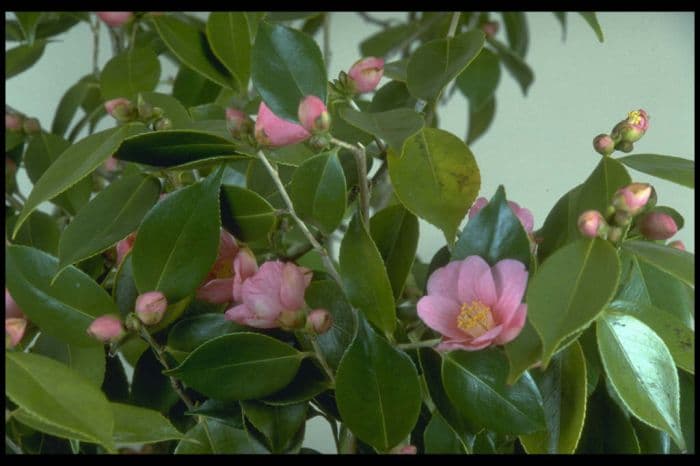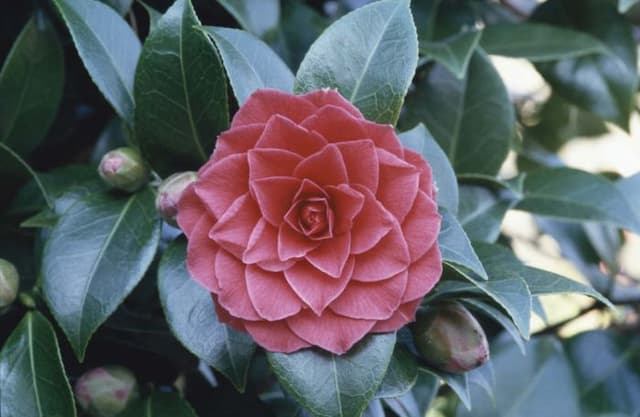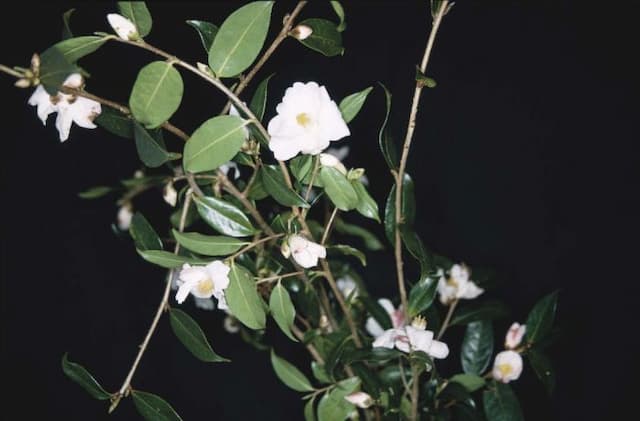Camellia Camellia 'Cornish Spring' (cuspidata × japonica)

ABOUT
Camellia 'Cornish Spring' is a visually stunning plant with a lush, evergreen presence that exudes elegance and charm. The plant is renowned for its beautiful flowers and glossy, dark green leaves. The flowers are particularly eye-catching, typically blooming in the early spring. They boast an alluring blend of white and pale pink shades, with petals that range from delicately ruffled to more classically rounded in shape. These blossoms are substantial and showy, often creating a magnificent contrast against the bold backdrop of the foliage. The leaves of the Camellia 'Cornish Spring' contribute to its year-round appeal, given their leathery texture and bright, enduring color. They are arranged alternately along the stems, offering a dense canopy that provides visual interest even when the plant is not in flower. The glossy surface of the leaves catches the light, giving the plant an almost luminous quality within the garden setting. Overall, the appearance of Camellia 'Cornish Spring' is characterized by its graceful symmetry and a striking harmony between its flowers and foliage, making it a favored choice for gardeners looking to add a touch of refined beauty to their outdoor spaces.
About this plant
 Names
NamesSynonyms
Spring Camellia, Cornish Spring Camellia.
Common names
Camellia cuspidata × Camellia japonica
 Toxicity
ToxicityTo humans
The Camellia plant, which includes the 'Cornish Spring' variety, is generally considered non-toxic to humans. Ingesting parts of the plant is not known to cause serious harm or poisoning. However, as with any plant not intended for consumption, individuals might experience mild gastrointestinal discomfort if ingested in large quantities.
To pets
The Camellia plant is also generally recognized as non-toxic to pets, including cats and dogs. While it is not likely to cause serious poisoning, pets that consume parts of the 'Cornish Spring' variety may experience mild gastrointestinal upset, such as vomiting or diarrhea. It is always advisable to prevent pets from eating plants as a precautionary measure.
 Characteristics
CharacteristicsLife cycle
Perennials
Foliage type
Evergreen
Color of leaves
Green
Flower color
White
Height
6-10 feet (1.8-3 meters)
Spread
5-7 feet (1.5-2.1 meters)
Plant type
Shrub
Hardiness zones
7
Native area
Japan
Benefits
 General Benefits
General Benefits- Aesthetic Appeal - Camellia 'Cornish Spring' is known for its beautiful flowers which bloom in spring, adding color and visual interest to gardens.
- Long Blooming Season - It has a relatively long blooming period compared to other plants, providing enjoyment over an extended time.
- Drought Tolerance - Once established, it is relatively drought-tolerant, requiring less frequent watering than some other plants.
- Shade Tolerance - This plant is capable of growing in shaded areas where other sun-loving plants may not thrive, making it versatile for different garden settings.
- Privacy Screen - With its dense foliage, it can be used as a natural privacy screen for yards or areas requiring a separation.
- Habitat for Wildlife - It can provide shelter and food for birds and insects, thus supporting local biodiversity.
- Low Maintenance - Camellia 'Cornish Spring' generally requires minimal pruning and care once established, making it ideal for gardeners of all levels.
- Evergreen - As an evergreen plant, it retains its leaves throughout the year, offering year-round greenery and structure in gardens.
 Medical Properties
Medical PropertiesThis plant is not used for medical purposes.
 Air-purifying Qualities
Air-purifying QualitiesThis plant is not specifically known for air purifying qualities.
 Other Uses
Other Uses- Culinary garnishes: The flower petals of Camellia 'Cornish Spring' can be used to decorate salads and desserts for an elegant touch.
- Eco-friendly dye: The petals can also be boiled to produce a natural dye for fabrics or craft projects.
- Pressed flower art: The blooms of the Camellia are ideal for pressing and using in artistic projects such as framed botanical art or handmade cards.
- Photography: Due to their striking appearance, Camellia 'Cornish Spring' flowers are commonly photographed and used in botanical prints and photo art.
- Wedding decor: The flowers can serve a decorative purpose in wedding bouquets, centerpieces, and venue decorations due to their lush and vibrant appearance.
- Tea ceremonies: In some cultures, the Camellia flowers can be used decoratively in traditional tea ceremonies to add natural beauty to the presentation.
- Floral waters: The petals can be used to infuse water with a mild fragrance for a natural, subtle room scent or for use in cosmetics.
- Crafting perfume: Camellia 'Cornish Spring' can be used in homemade perfumes for its light and appealing scent, though it's less common than other fragrance sources.
- Floral baths: The petals can be added to bathwater to create a luxurious and visually appealing bathing experience.
- Composting: After the flowers fade, they can be composted to create a nutrient-rich soil amendment for gardening.
Interesting Facts
 Feng Shui
Feng ShuiThe Camellia is not used in Feng Shui practice.
 Zodiac Sign Compitability
Zodiac Sign CompitabilityThe Camellia is not used in astrology practice.
 Plant Symbolism
Plant Symbolism- Adoration and Devotion: In Victorian times, giving someone a Camellia was a way to express adoration. The gorgeous blooms of the 'Cornish Spring' variety reinforce this symbolism of deep devotion and admiration.
- Perfection and Excellence: The flawless beauty of Camellia blossoms has long been associated with perfection and the pursuit of excellence. The 'Cornish Spring', with its beautiful flowers, embodies this ideal.
- Longevity and Faithfulness: With Camellias being evergreen and their blooms reappearing each season with unchanging beauty, they symbolize the everlasting nature of love and the faithfulness of a relationship.
- Desire and Passion: The rich colors and lush petals of the Camellia can represent desire and deep passion, making them an appropriate gift for someone you have strong feelings for.
- Refinement and Thoughtfulness: Historically, the Camellia is a symbol of refinement. Gifting 'Cornish Spring' Camellias can be seen as a gesture of thoughtfulness and an appreciation for the finer things in life.
 Water
WaterThe Camellia 'Cornish Spring', commonly known as the Camellia, requires consistent moisture and should be watered when the top inch of soil feels dry to the touch. It's best to use rainwater or distilled water to avoid leaf tip burn from mineral deposits in tap water. Provide the plant with about 1 gallon of water per week, ensuring it soaks into the soil to reach the roots without leaving the soil waterlogged. During the growing season in spring and summer, increased watering frequency may be necessary, especially if the weather is particularly dry or hot. In contrast, reduce watering in the fall and winter when the plant is not actively growing.
 Light
LightThe Camellia prefers partial shade to dappled sunlight, doing well in a spot that receives morning sun and afternoon shade. Direct afternoon sun can be too intense and may cause leaf scorch, particularly in southern climates. The ideal location offers bright, filtered light to protect the delicate blooms and leaves while providing enough light for healthy growth.
 Temperature
TemperatureCamellias thrive in a temperature range of 60 to 75 degrees Fahrenheit for optimal growth but can tolerate a range from around 0 to 80 degrees Fahrenheit. Extremes beyond these temperatures may damage the plant. It's important to avoid exposing the Camellia to sudden temperature fluctuations, especially during the flowering period.
 Pruning
PruningPrune Camellias to maintain shape, remove dead or weak growth, and encourage vigorous new growth that will support next season's blooms. The best time to prune is right after the flowers have finished blooming in the spring. You can prune the Camellia once a year, carefully snipping away any overcrowded branches or stems that disrupt the plant's symmetry.
 Cleaning
CleaningAs needed
 Soil
SoilThe best soil mix for Camellia 'Cornish Spring' should be well-draining and rich in organic matter with an acidic pH between 5.5 - 6.5. A mixture of equal parts peat, pine bark, and coarse sand or perlite is ideal for this camellia.
 Repotting
RepottingCamellia 'Cornish Spring' should be repotted every 2-3 years or when it becomes root-bound. Repotting is best done in the late winter or early spring, just before the growing season begins.
 Humidity & Misting
Humidity & MistingCamellia 'Cornish Spring' thrives in moderate to high humidity levels, ideally between 40-60%. If the indoor air is dry, increasing humidity around the plant can be beneficial.
 Suitable locations
Suitable locationsIndoor
Place in bright, indirect light and maintain high humidity.
Outdoor
Shelter from strong winds, partial shade, well-draining acidic soil.
Hardiness zone
7-9 USDA
 Life cycle
Life cycleThe Camellia 'Cornish Spring', also known simply as Camellia, begins its life as a seed, which after a period of dormancy, germinates in conducive conditions of moisture and temperature. The seedling then emerges and establishes itself with a set of true leaves, entering a growth phase where it develops a root system and foliage through photosynthesis. As the plant matures, it forms buds that lead to the flowering stage, usually in late winter to early spring, showcasing vibrant flowers. Once pollinated, these flowers then produce seed-containing fruit, completing the reproductive cycle. After several years of growth, Camellia 'Cornish Spring' reaches maturity and can continue its vegetative growth while cycling through annual bloom and seed production stages. Camellias can be long-lived, with some specimens surviving for over a century, continuously contributing to the landscape with their evergreen beauty and seasonal flowers.
 Propogation
PropogationPropogation time
Early Spring
The most popular method of propagating Camellia 'Cornish Spring', also known as Camellia, is through semi-hardwood cuttings. This is typically done in late summer when the new growth has started to mature and harden slightly. Cuttings should be about 4 to 6 inches long and contain at least two sets of leaves. The lower leaves should be removed, and the cut end dipped in rooting hormone before being placed in a well-draining potting mix. The cutting needs to be kept under high humidity, which can be achieved by covering it with a plastic bag or dome, and kept in bright, indirect light until roots develop, which usually takes several weeks to a few months. During that time, it's critical to keep the soil consistently moist but not waterlogged.









